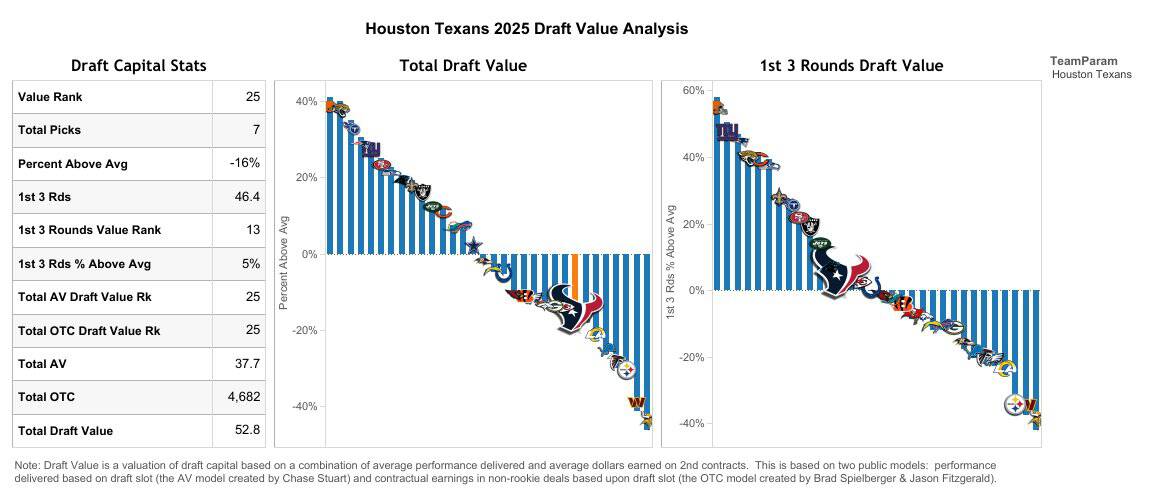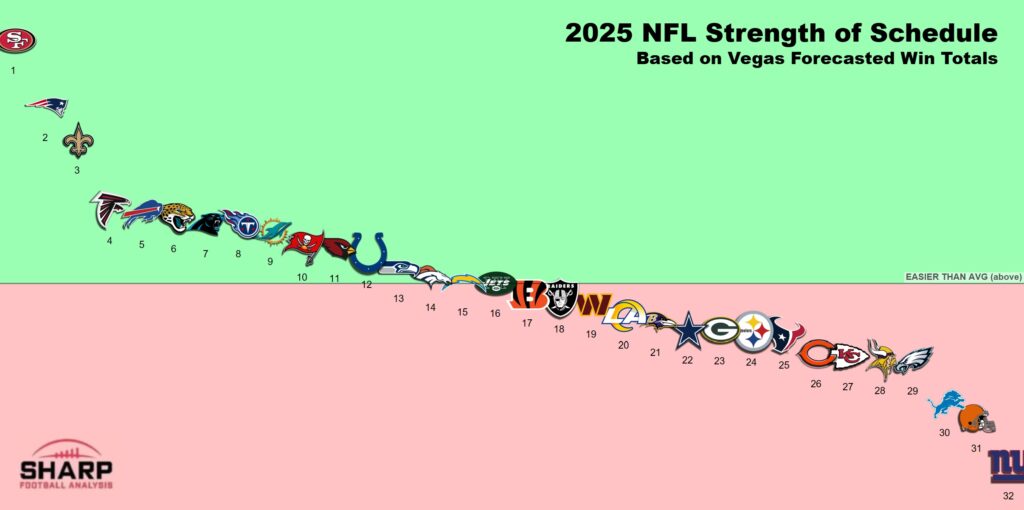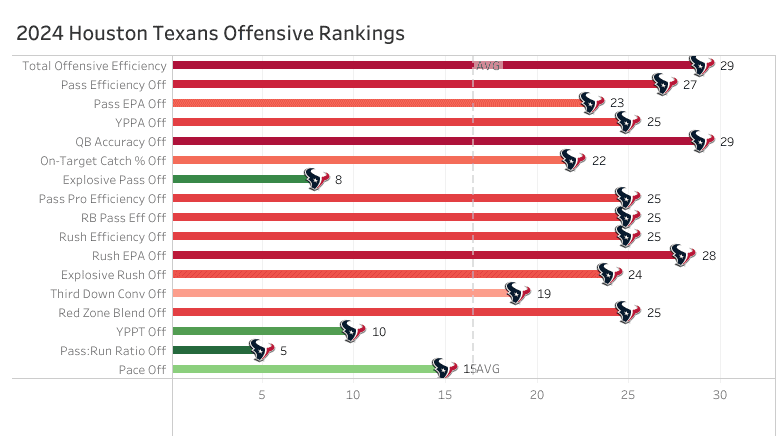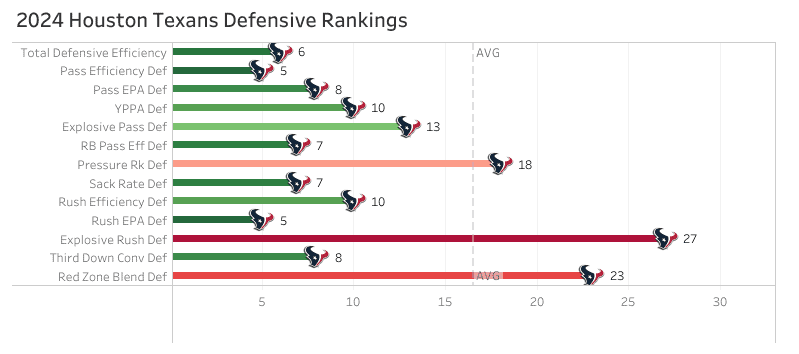As a lead-up to the 2025 NFL draft, we've broken down the current depth chart of every NFL team and identified the biggest draft and team needs for the Houston Texans.
You can find additional team-by-team draft needs articles and other draft content on our 2025 NFL Draft Hub.
Houston Texans Needs: Top Positions of Need in 2025
- Offensive Line
- Wide Receiver
- Defensive Back
What Picks Do the Houston Texans Have in 2025?
The Houston Texans have 7 picks in the 2025 NFL Draft, including:
- Round 1 (25)
- Round 2 (58)
- Round 3 (79)
- Round 3 (89)
- Round 5 (166)
- Round 7 (236)
- Round 7 (241)
Preorder The Best Analytical 2025 Football Preview
Don't miss out on Warren Sharp's 500+ page preview of the 2025 NFL season.
The preview is unlike anything you have ever seen, featuring stunning visualizations built with the reader in mind.
This preview shares insights into players, coaches, teams, and philosophies with one goal in mind: to get you prepared for the 2025 NFL season by delivering the smartest information in the fastest, most direct way possible.
Preorder the 2025 Football Preview now!
Houston Texans 2025 Draft Capital Stats
The Texans have the 25th-most draft capital according to our Sharp Football Draft Value.
Our Sharp Football Draft Value is a valuation of draft capital based on a combination of average performance delivered and average dollars earned on second contracts.
Houston Texans Draft Value vs. Other Teams:
The Texans’ draft value is 16% lower than the league average of all 32 teams.
Houston Texans Draft Prediction:
Find out who our top-rated experts expect the Texans to draft:
- Brendan Donahue's 2025 NFL Mock Draft – Complete first round breakdown from the #2 most accurate mock drafter over the last five seasons.
- Ryan McCrystal's 2025 NFL Mock Draft – Complete first round breakdown from the #8 most accurate mock drafter over the last five seasons.
Houston Texans Strength of Schedule, 2025
The Houston Texans have the 25th-easiest NFL strength of schedule for the 2025 NFL season.
Houston Texans Offense: Depth Chart, Analysis & Draft Needs
Rich Hribar breaks down the offensive depth chart by position for the Houston Texans, identifying areas where the team could improve in the upcoming 2025 NFL Draft.
Quarterback Depth Chart, Texans:
- C.J. Stroud
- Davis Mills
- Kedon Slovis
C.J. Stroud took a step back across the board in his second season, completing 63.2% of his passes (27th) for 7.0 yards per attempt (22nd) and a 3.8% touchdown rate (29th).
Stroud’s career got off to a fantastic start as a rookie, but then he was pulled down by natural regression, several injuries to his surrounding playmakers, and a mish-mash offensive line.
The offensive line was also battered and bad during his rookie season, but Stroud did a worse job mitigating damage through sacks in 2024.
Stroud was pressured on 38% of his dropbacks last season (28th) but took a sack on 8.9% compared to a 7.1% rate as a rookie.
What compounded matters is that he took a sack on 15.5% of his dropbacks on third down (34th in the league) compared to a 6.1% rate as a rookie (fourth lowest).
One of the exciting aspects for Stroud coming into his second season was that he would be throwing the ball to Nico Collins, Stefon Diggs, and Tank Dell.
Well, he only threw 66 total passes last season with all three of those receivers on the field.
He averaged 7.8 Y/A on those plays with a 4.5% touchdown rate, which are good numbers.
He also ended the season with fewer pass attempts (182) than in 2023 (190), with Collins and Dell on the field.
Many questions we ended the season surrounding the Houston pass catchers and offensive line remain unanswered.
Still, we know Stroud is the franchise's foundation, with two years remaining on his rookie deal for the team to capitalize on.
Running Back Depth Chart, Texans:
- Joe Mixon
- Dameon Pierce
- Dare Ogunbowale
- J.J. Taylor
- British Brooks
- Jawhar Jordan
Joe Mixon had a strong first season with the Texans.
He averaged 17.5 rushes for 72.6 yards per game, his highest rates since 2021.
He scored 12 times over 14 games after scoring 12 times over 17 games in 2023.
Mixon only had a 32.2% success rate as a runner (43rd), but we can come back to the offensive line's issues in contributing to that rate.
Mixon averaged 2.92 yards after contact per rush, his highest rate since 2021.
His 1.22 yards before contact per rush were his lowest since 2021.
Mixon also had a run of 10 or more yards on 11.4% of his runs, his highest rate since 2018.
When Mixon was on the field, he was getting the ball.
In his games played, he handled 79.6% of the backfield touches.
Houston did not trust their depth behind Mixon.
Dameon Pierce (40 attempts) and Dare Ogunbowale (30) combined for only 70 rushes.
The team had Cam Akers to start the season, but traded him to Minnesota after Week 6.
Mixon still has two more seasons on his current contract.
The team has hinted that they are exploring an addition to the backfield during the draft.
They have used top-30 visits on Kaleb Johnson and Quinshon Judkins.
Wide Receiver Depth Chart, Texans:
- Nico Collins
- Christian Kirk
- Tank Dell
- John Metchie
- Xavier Hutchinson
- Justin Watson
- Braxton Berrios
- Jared Wayne
- Xavier Johnson
- Johnny Johnson
Nico Collins caught 68 passes for 1,006 yards and 7 touchdowns over 12 games this season.
A mid-season hamstring injury slowed him down from his blistering pace to open the season.
He had one 100-yard game after returning in Week 11 after going over 100 yards in three of the first five games this season.
However, he still managed to post 2.87 yards per route run, third among wide receivers behind Puka Nacua (3.57) and A.J. Brown (3.04).
When Collins was on the field, he was targeted on 28.3% of his routes with 33.4% of the team's targets.
Collins missed 5 games but accounted for 39.4% of the team's targets in the red zone and 57.9% of the end zone targets when he was available.
Both would have been top-five rates for a wide receiver over the entire season.
Of the top-10 individual seasons in yards per route run over the past two seasons, Collins is on the list twice.
The only other wide receiver there twice is Nacua.
Houston jumped at extending Collins early last offseason, which looks like it will be valuable.
Collins only has a cap hit of $8.6 million this season, but even his remaining years of $27.6 million and $28.8 million through 2027 are underpriced based on the market.
Christian Kirk appeared to be headed to free agency as a cap casualty, but the Texans swooped in and made an inter-division trade with the Jaguars to add the veteran for a seventh-round pick in the 2026 draft.
This is a solid move for the Texans, who needed the wide receiver position.
Tank Dell’s availability is in question for the 2025 season after a brutal knee injury suffered late in the season.
Dell just had a second knee surgery to repair the ACL component of that injury in March.
Stefon Diggs was not retained in free agency.
Asking Kirk to be a proxy for what Houston was getting from Diggs before his injury is well within reason.
Kirk is a younger player capable of filling the slot role vacated by Diggs.
Before his injury, Diggs was averaging 5.9 receptions for 62.0 yards per game.
Kirk can take advantage of playing next to a true alpha receiver in Collins and will be attached to viable quarterback play.
With Collins on the field, Diggs was targeted on 22.3% of his routes, which aligns with Kirk’s recent rates.
Kirk is potentially a one-year rental for this upcoming season, and the lack of unproven production this depth chart has accrued to this stage leaves room for more additions.
John Metchie and Xavier Hutchinson still have meat left on their rookie contracts, but both have been underwhelming assets.
Metchie and Hutchinson have combined for 60 receptions in the past two seasons despite the Houston wide receiver room suffering multiple injuries in both seasons.
The team added Justin Watson and Braxton Berrios on short-term contracts as veteran depth, but neither has much production to lean on.
Tight End Depth Chart, Texans:
- Dalton Schultz
- Cade Stover
- Brevin Jordan
Dalton Schultz took a step back this season, catching 53 passes for 532 yards and 2 touchdowns.
His 3.1 catches for 31.3 yards per game were his worst rates since 2019.
Schultz was still on the field for 77.5% of the dropbacks this season, fifth among tight ends this season.
Schultz is still signed for two more seasons, but Houston could get out of his contract after this season while recouping $11.5 million in cap space in 2026.
Cade Stover only caught 15 passes for 133 yards and a touchdown as a rookie, but he contributed to the run game.
As a rookie, he ranked eighth in run blocking grade per Pro Football Focus among tight ends while blocking on 61.9% of his snaps.
Houston could add a pass catcher here in preparation for moving on from Schultz.
They did use a top-30 visit on Elijah Arroyo.
Offensive Line Depth Chart, Texans:
LT: Cam Robinson, Zach Thomas, Austin Deculus
LG: Tytus Howard, Laken Tomlinson, Tremayne Anchrum, LaDarius Henderson
C: Jarrett Patterson, Jerome Carvin
RG: Juice Scruggs, Ed Ingram, Nick Broeker
RT: Blake Fisher, Trent Brown, Jaylon Thomas
This offensive line was at the root of most of the issues this offense faced last season.
Houston ended the season 22nd in ESPN’s pass block win rate (58%) and 31st in run block win rate (68%).
At Pro Football Focus, they were 21st in pass blocking grade and 25th in run blocking grade.
They had the unfortunate combination of being subpar and injured.
Houston’s most-used combination on the line played together for 35.1% of the snaps.
There were rumors that the linemen's room here was an issue behind closed doors.
That was never confirmed, and DeMeco Ryans downplayed things, but the Texans have come close to clearing things out this offseason.
They traded their best offensive lineman, Laremy Tunsil.
Not only was Tunsil their best player up front, but he was also the only one who played in every game.
Tunsil did have 19 penalties, but he was still excellent in pass protection, allowing a 3.1% pressure rate (sixth best among tackles).
The team also traded away Kenyon Green (who led the team in snaps at right guard) and did not bring back Shaq Mason (who led the team in snaps at right guard).
Houston is throwing a lot of underwhelming pieces at the line and shuffling up the players they have retained.
The team has added veteran tackles Cam Robinson and Trent Brown.
Robinson allowed a 9.3% pressure rate (92nd) with 13 penalties (94th) with Jacksonville and Minnesota last season.
Brown will be 32 this season and has played only 14 games in the past two seasons.
They also added veterans Laken Tomlinson and Ed Ingram.
Ingram allowed a 7.2% pressure rate last season, 87th among guards.
If looking for the silver lining, Green was 88th.
Tomlinson was 49th among guards in overall grade per Pro Football Focus, which was one spot below Mason.
Tytus Howard led the team with 812 snaps at right tackle last season but is expected to move inside this season.
Howard still has two seasons left on his rookie contract.
Juice Scruggs still has two years left on his rookie deal and is expected to compete for a spot inside.
He played 568 snaps at center, 250 snaps at left guard, and 53 snaps at right guard last season.
Jarrett Patterson played 537 snaps at center, ranking 32nd in overall grade at the position.
It is not a secret that Houston is far from done here.
They have used pre-draft visits on tackles Charles Grant, Chase Lundt, and Grey Zabel.
Houston Texans Defense: Depth Chart, Analysis & Draft Needs
Raymond Summerlin breaks down the defensive depth chart by position for the Houston Texans, identifying areas where the team could improve in the upcoming 2025 NFL Draft.
Defensive Line Depth Chart, Texans:
- Sheldon Rankins
- Tim Settle Jr.
- Denico Autry
- Mario Edwards Jr.
- Kurt Hinish
- Tommy Togiai
- Jayden Peevy
The Texans were mostly good against the run in 2024, finishing fourth in yards allowed per carry to running backs (3.9).
They did give up some big plays (9.1% big play rate to RBs, 25th), but they also finished 11th in negative run rate against running backs.
Sheldon Rankins is back after a failed one-year stint with the Bengals.
He was productive with the Texans in 2023, logging 6 sacks and a solid 11% pressure rate.
Tim Settle is the top returner along the defensive line after setting a career high with 625 snaps in his first season with the Texans.
He tied his career best mark with 5 sacks while logging a 10% pressure rate.
Settle also had 7 run stuffs.
Denico Autry continued his usage as a hybrid lineman/edge player in his first season in Houston, getting 3 sacks in 10 games.
Mario Edwards also finished with 3 sacks.
The concern here is that while the Texans do have a lot of guys, none of them played particularly good against the run last season, several are older, and Rankins, Settle, and Autry are heading into contract years.
Defensive line is not a pressing need, but adding some youth makes sense.
EDGE Depth Chart, Texans:
- Will Anderson Jr.
- Danielle Hunter
- Derek Barnett
- Darrell Taylor
- Dylan Horton
- Solomon Byrd
- Kingsley Jonathan
- Casey Toohill
Houston finished fourth with 49 sacks in 2024, but their 33.2% pressure rate ranked 20th.
That pressure rate is not a terrible number, but it does point to some luck in that sack total.
Then again, Houston does have one of the best pass rushing pairs in the league.
Despite being limited to 14 games, Will Anderson logged 11 sacks in his second season, finishing 12th among qualified pass rushers in pressure rate (14.7%).
Danielle Hunter also did his part during his first season with the team, getting 12 sacks with a very good 13.9% pressure rate.
It is fair to wonder how good the depth is behind those two.
Derek Barnett did get 5 sacks on limited playing time, but his 8.7% pressure rate would have ranked 80th in the league if he had played enough snaps to qualify.
2023 fourth-round pick Dylan Horton has an amazing story, returning from a cancer diagnosis to play 13 games last season.
There should be hope that he takes a step forward after a healthy offseason.
The X factor could be Darrell Taylor, who was signed away from the Bears in free agency.
He only got 3 sacks for Chicago playing relatively limited snaps, but he set a career high with a 14.2% pressure rate.
Taylor also had 9.5 sacks for the Seahawks back in 2022 while still on his rookie deal.
Perhaps the former second-round pick can find another level and really take over the No. 3 spot.
If he does, he could be in for a nice payday in free agency next spring, and Barnett is also in the final year of his deal.
The Texans are fine here given the talent at the top of the depth chart, but it also would not be shocking if they looked to add in the draft with an eye toward the future.
Linebacker Depth Chart, Texans:
- Azeez Al-Shaair
- Henry To’oTo’o
- E.J. Speed
- Christian Harris
- Jake Hansen
- Nick Niemann
- Jamal Hill
Azeez Al-Shaair was limited to 11 games in his first season with the Texans, in part because of a suspension for a bad hit, but he looked like a good addition when on the field.
Al-Shaair finished with 8 run stuffs in those 11 games, recording a tackle on 21.2% of his run defense snaps.
He was not at that same level in coverage, allowing a 92.8 quarterback rating, but that is a solid enough showing.
Henry To’oTo’o was the other primary option at linebacker a season ago, leading the team with 10 run stuffs but really struggling in coverage.
Through two seasons, he has allowed a 127.9 quarterback rating in his coverage with 7 touchdowns.
E.J. Speed was added in free agency, and he will likely compete for snaps with 2022 third-round pick Christian Harris, who was limited to three games a season ago.
Harris has good speed and was good in coverage over his first two seasons, so he could get more run on obvious passing downs should To’oTo’o continue to struggle.
Harris and Speed are both entering contract years, raising some longer term concerns, but this is a decent top four.
Cornerback Depth Chart, Texans:
- Derek Stingley Jr.
- Kamari Lassiter
- Ronald Darby
- Tremon Smith
- D’Angelo Ross
- Gregory Junior
The Texans were good overall against the pass in 2024, allowing 6.8 yards per attempt (5th) and recording 19 interceptions, the second best mark in the league.
The one place they struggled was giving up touchdowns, admittedly an important aspect of playing defense.
Houston allowed 31 passing scores (30th) and a 5.6% touchdown rate (29th).
Despite the touchdown issues, the Texans have to be happy with where they are at the top of this depth chart.
Derek Stingley played all 17 games for the first time in his career and earned his first All Pro nod.
He finished fourth among qualified corners in yards allowed per coverage snap and was second with 18 passes defensed.
Stringley signed a three-year extension this offseason, keeping him with the team through the 2029 season.
A 2024 second-round pick, Kamari Lassiter hit the ground running as a rookie, allowing just 5.8 yards per target and a 64 quarterback rating in his coverage across 14 games.
Assuming Lassiter keeps it up in year two, the Texans suddenly have one of the best young corner duos in the league.
Houston added Ronald Darby in free agency, but he is coming off a rough season with the Jaguars.
That raises questions about the depth behind the top two, but Houston struck gold with Jalen Pitre playing as the slot corner last season, and they signed him to an extension this offseason.
Even so, adding another young corner to this group makes a lot of sense.
Safety Depth Chart, Texans:
- Jalen Pitre
- Calen Bullock
- C.J. Gardner-Johnson
- Jimmie Ward
- M.J. Stewart
- Russ Yeast
As mentioned above, Jalen Pitre perhaps belongs in the corner group, but we will keep him here for now.
Either way, he came into his own playing as the nickel corner in 2024 and earned his offseason extension.
The Texans remade their secondary early in the 2024 draft, adding Calen Bullock in the third round after spending their second rounder on Lassiter.
Bullock was nearly an every-down player as a rookie, finishing third among qualified safeties in yards allowed per coverage snap.
The other primary option at safety, Eric Murray, left in free agency, and the Texans filled that hole by acquiring C.J. Gardner-Johnson.
Gardner-Johnson had a resurgent season in his return to the Eagles last year, starting 16 games and helping them win the Super Bowl.
Staying on the field has never been his strong suit, and backup Jimmie Ward is not known for his availability, either.
Given that uncertainty and the fact that Pitre is likely going to play a lot at corner, adding some young depth here makes sense.





















